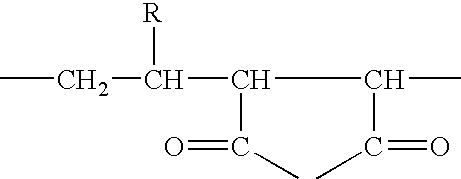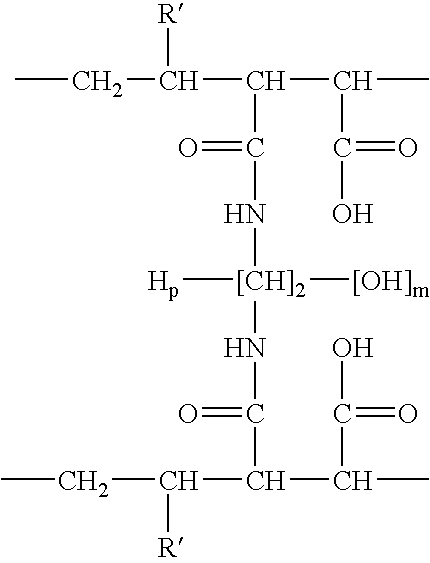Compositions and methods for proteomic investigations
a technology of proteomic investigations and compositions, applied in the field of compositions and methods for proteomic investigations, can solve problems such as complexity, current proteomic investigations are severely hampered, and current data acquisition technology
- Summary
- Abstract
- Description
- Claims
- Application Information
AI Technical Summary
Benefits of technology
Problems solved by technology
Method used
Image
Examples
example 4
[0215] Two-Step Glycoprotein Resolution on Chitosan-DEA Beads
[0216] The results given in Reference Examples 3 and 4 have shown that treatment of serum or plasma with polyelectrolyte CPPA removes most of the albumin and some of the immunoglobulins, enriching glycoproteins in the supernatant fraction. Consequently, use of CPPA enrichment as a first step in the analysis of glycoproteins is recommended to reduce the complexity of a protein mixture applied to a specificity-determining substrate. Furthermore, the remaining glycosylated fraction is in its native state and biologically active (see Example 11).
[0217] This Example demonstrates that glycoproteins may be first enriched from serum, and then can be applied to a specificity-determining substrate (chitosan-DEA in bead format) for further resolution and analysis tested in a well based format.
[0218] The serum was treated with the polyelectrolyte CPPA as previously described, and the supernatant thus obtained, enriched for glycoprote...
example 7
[0244] Preferential Binding Character of Ligands attached to derivatized beads
[0245] Four derivatized crosslinked chitosan preparations, bearing, respectively, an aliphatic carboxylic acid, a phenolic tricarboxylic acid, a phenolic carboxylic acid, and a branched amine, were tested for their ability to resolve protein in plasma. The results are shown in Fig. 6. These electrophoretic profiles show that certain proteins flow through, while others are preferentially retained to different extents by macrobeads with the four different ligands. These results show that differing ligand binding affinities sort proteins in differential fashion, and can reveal low abundance proteins in a mixture. This selectivity contributes to the analysis of proteins in proteomics investigations.
[0246] Example 8. Evaluation of Ligand Substituted Crosslinked Chitosan Beads
[0247] The ability of crosslinked chitosan derivatized with various ligands to resolve proteins in a mixture was examined in this Example...
example 10
[0259] Analysis Of Alpha-1 Acid Glycoprotein Dosed Into Plasma Using Glycoprotein Enrichment And Chitosan-Ligand Beads.
[0260] The chitosan-ligand beads were equilibrated by first washing with 10mM Potassium Phosphate buffer pH 6.0 until the pH was even across all bead samples. 1.0 mL of Sheep Plasma (Lot# 109205PNaEDTAI) dosed with 1mg / mL alpha-1 acid glycoprotein was added to 1.0mL acidic polyelectrolyte hydrogel, the mixture was then mixed for 15 minutes using an orbital shaker. The mixture was then centrifuged and the supernatant was retained. The supernatant was then subjected to a set of chitosan-ligand derivatized beads (C, D, E, J, 1 and 6 (Table 9)). The supernatant (flowthrough) from the previous step was then diluted to 5mL using distilled water.
[0261] 0.4mL of Sample (Diluted Flowthrough) was then added to 0.25mL of chitosan bead samples in a 96-well microtiter plate. The plate containing the mixtures was then mixed for 10 minutes and the second supernatant was recovered...
PUM
| Property | Measurement | Unit |
|---|---|---|
| Volume | aaaaa | aaaaa |
| Volume | aaaaa | aaaaa |
| Volume | aaaaa | aaaaa |
Abstract
Description
Claims
Application Information
 Login to View More
Login to View More - R&D
- Intellectual Property
- Life Sciences
- Materials
- Tech Scout
- Unparalleled Data Quality
- Higher Quality Content
- 60% Fewer Hallucinations
Browse by: Latest US Patents, China's latest patents, Technical Efficacy Thesaurus, Application Domain, Technology Topic, Popular Technical Reports.
© 2025 PatSnap. All rights reserved.Legal|Privacy policy|Modern Slavery Act Transparency Statement|Sitemap|About US| Contact US: help@patsnap.com



